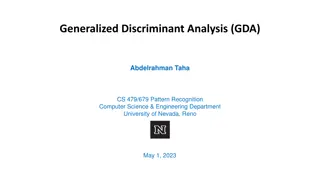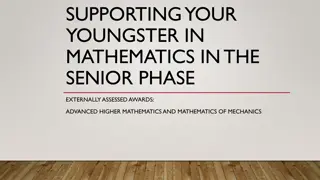Understanding Quotient Spaces in Mathematics
In group theory, a subgroup H of a group G helps decompose G into equal-size disjoint subsets called cosets. Quotient spaces in mathematics involve equivalence classes under a given relation and a specific topology. Furthermore, in linear algebra, the quotient of a vector space by a subspace results in a new vector space. Explore the concept of quotient spaces and their applications in various mathematical contexts.
Download Presentation

Please find below an Image/Link to download the presentation.
The content on the website is provided AS IS for your information and personal use only. It may not be sold, licensed, or shared on other websites without obtaining consent from the author. Download presentation by click this link. If you encounter any issues during the download, it is possible that the publisher has removed the file from their server.
E N D
Presentation Transcript
QUOTIENT SPACES CHAPTER 3
In mathematics, specifically group theory, a subgroup H of a group G may be used to decompose the underlying set of G into disjoint equal-size subsets called cosets. There are left cosets and right cosets. Cosets (both left and right) have the same number of elements (cardinality) as does H. Furthermore, H itself is both a left coset and a right coset. The number of left cosets of H in G is equal to the number of right cosets of H in G. This common value is called the index of H in G and is usually denoted by [G : H]. COSETS
The quotient space of a topological space and an equivalence relation on is the set of equivalence classes of points in (under the equivalence relation ) together with the following topology given to subsets of : a subset of is called open iff is open in . Quotient spaces are also called factor spaces. Quotient space
Suppose if A is group, and B is subgroup of A, and is an element of A, then aB = {ab : b an element of B } is left coset of B in A, The left coset of B in A is subset of A of form aB for some a(element of A). In aB(left coset), a is representative of coset. And Ba = {ba : b an element of B } is right coset of B in A. The right coset of B in A is subset of A of form Ba for some a(element of A). In right coset Ba, element a is referred to as representative of coset.
In linear algebra, the quotient of a vector space V by a subspace N is a vector space obtained by "collapsing" N to zero. The space obtained is called a quotient space and is denoted V/N (read "V mod N" or "V by N"). DIMENSION S OF A QUOTIENT SPACE
Formally, the construction is as follows.[1]Let V be a vector space over a field K, and let N be a subspace of V. We define an equivalence relation ~ on V by stating that x ~ y if x y N. That is, x is related to y if one can be obtained from the other by adding an element of N. From this definition, one can deduce that any element of N is related to the zero vector; more precisely, all the vectors in N get mapped into the equivalence class of the zero vector.
The equivalence class or, in this case, the coset of x is often denoted [x] = x + N since it is given by [x] = {x + n : n N}. The quotient space V/N is then defined as V/~, the set of all equivalence classes over V by ~. Scalar multiplication and addition are defined on the equivalence classes by[2][3] [x] = [ x] for all K, and [x] + [y] = [x + y]. It is not hard to check that these operations are well-defined (i.e. do not depend on the choice of representatives). These operations turn the quotient space V/N into a vector space over K with N being the zero class, [0]. The mapping that associates to v V the equivalence class [v] is known as the quotient map. Alternatively phrased, the quotient space V/N is the set of all affine subsets of V which are parallel to N.























